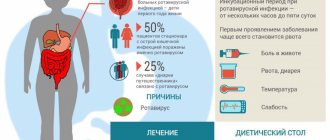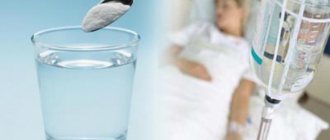Vomiting can occur in a child for a variety of conditions, including food poisoning, allergies, metabolic problems, acute appendicitis, neurological disorders and many others. One of the most common causes of vomiting is rotavirus infection, which is more susceptible to children under 6 years of age. Although the disease can occur at older ages, as well as in adults.
For children, rotavirus is especially dangerous, as it can lead to rapid dehydration and other serious consequences. Many parents are interested in how to stop vomiting in a child due to rotavirus at home. In this case, first of all, adults should show the child to a doctor to make sure that the baby’s condition is not critical and does not require immediate hospitalization. And one of the most important rules that parents should remember is not to give their child medications without consulting a doctor, so as not to worsen his condition.
General characteristics of rotavirus infection
Rotavirus infection, also called rotavirus gastroenteritis, is an acute disease. Its causative agents are several types of rotaviruses. Once in the gastrointestinal tract of a person with a weakened or immature immune system (children aged 6 months to 6 years, as well as the elderly, are primarily at risk), rotavirus disrupts healthy digestion and leads to vomiting, diarrhea (frequent loose stools) and other symptoms , which will be discussed below.
The disease develops in three stages:
- The incubation period, which can last from 1 to 5 days.
- An acute period of illness, usually lasting up to 7 days (however, in severe cases it can last longer).
- Recovery stage (on average 4-5 days). At this time, the child can remain a carrier of infection and cause infection to others, so the baby’s contact with other people should be limited.
Each phase is characterized by its own symptoms, including not only vomiting and diarrhea, but also a runny nose, sore throat, and redness of the laryngeal mucosa.
Due to the fact that the disease occurs with fever and catarrhal symptoms, rotavirus is often called “intestinal flu,” but you need to understand that it has nothing in common directly with the flu.
Recovery from rotavirus
Children exposed to rotavirus infection need special care and nutrition. The intestine damaged by viruses cannot fully perform its functions3. Therefore, nutrition should be gentle10:
- infants continue to be fed breast milk1,10 at least 6 times a day, initially reducing the amount of food (feeding time) by 30–50%1,10.
- Formula-fed children are first transferred to low- and lactose-free breast milk substitutes3,10, then, when the condition improves, lactose-containing products are introduced into the diet1,10.
- Older children receive their usual drinks and foods2, with the exception of those that enhance fermentation, stimulate the motor activity of the gastrointestinal tract and the secretion of digestive juices10.
During the recovery period, the use of multivitamin-microelement complexes may be justified, restoring the balance of substances necessary for the body, such as folate, vitamin A, copper, zinc, magnesium1.
Up to contents
Ways of infection with the virus
It is quite easy to become infected with rotavirus. And due to the long incubation period, it is almost impossible to determine exactly how the infection entered the body.
Doctors identify four main routes of infection with rotavirus:
- Fecal-oral route - from a sick person to a healthy person
- Contact and household path. The point is that a child can become infected with rotavirus simply by touching objects in public places - schools, kindergartens, hotels, shops, etc. Therefore, do not forget to wash your hands before eating and remind your child of the importance of following hygiene rules.
- Airborne path. Sometimes a child only needs to talk to a carrier of the infection to get sick himself, since the virus easily spreads in the air when coughing, sneezing, or blowing his nose.
- Upon contact with contaminated water. You can become infected with rotavirus simply by swimming in contaminated water. The microbes that cause the disease are resistant to detergents, freezing, etc. They die only in hot water - at least 60 degrees Celsius and after treatment with strong cleaning agents. This is one of the reasons why it is not recommended to swim in small bodies of water with stagnant water or in pools whose cleanliness is questionable.
Signs of rotavirus disease
In children, rotavirus infection usually develops according to a certain “schedule”. The first symptom is a sharp increase in body temperature (up to 39 degrees Celsius), followed by refusal to eat, vomiting, and diarrhea.
It is possible to determine that the cause of the illness is rotavirus by looking at stool, which has distinctive features. In the first days, the stool is usually liquid and yellow, and in subsequent days it acquires a strong unpleasant odor due to the activation of opportunistic flora.
One of the reasons why rotavirus is often called “stomach flu” is that it has some similarities with colds and respiratory diseases: there is severe redness of the mucous membranes of the throat, runny nose, sore throat, and discomfort when swallowing.
In addition, the child becomes weak and loses his appetite. Vomiting may occur after eating. Many babies complain of abdominal pain. Dehydration occurs quickly, manifested by the following symptoms:
- lethargy;
- dryness of the skin, as well as lips and mucous membranes;
- a sharp decrease in body weight.
Intestinal infection: how to avoid hospital
Authors : Shcherbina E. A.
What is acute intestinal infection?
Acute intestinal infection (AI) is an infectious inflammation of the stomach and intestines, which is manifested by diarrhea (loose stools more than 3 times a day), sometimes nausea, vomiting and fever. In approximately 80% of cases, intestinal infections are caused by viruses (very often rotavirus), meaning the use of antibiotics will have no effect.
What to be afraid of during an intestinal infection and how to avoid ending up in the hospital
The most dangerous thing for a child with diarrhea and vomiting is dehydration. It is because of this that a child has to be hospitalized if the parents were unable to get him drunk. We will discuss in great detail below how to prevent this.
What should I do if my child gets ACI?
Most often, mild intestinal infections can be treated at home. If symptoms of the disease appear, it is advisable to contact your doctor and warn him that your child is sick and describe the entire situation in detail. Diarrhea and vomiting (plus an increase in temperature) are a loss of water and salts, which means that the first and main thing parents should do is to make up for existing losses and constantly compensate for what will be lost further.
How much fluid should I give?
On average, to feed a child with an acute intestinal infection, you need approximately 100 ml per kilogram of body weight (1000 ml for a child weighing 10 kg), but more may be needed. To make it more comfortable, you need to make sure that your baby has moist skin and pees about once every three hours. If you pee less often, it means you haven’t worked hard, let’s drink more until urination becomes more frequent.
What to solder with?
The ideal solution for replenishing fluids during an intestinal infection is saline solutions. They are sold in pharmacies or can be prepared at home: three level teaspoons of sugar plus 1/2 teaspoon of salt per liter of boiled water. Not everyone, especially small children, is delighted with these drinks, but the losses still need to be made up. If a small patient refuses to drink saline solution, cook him a dried fruit compote. If this does not help, then you can give absolutely any liquid that the child will drink: even ordinary water, even tea, even a watermelon to eat, even sweet water from the store - as long as he drinks! (The harm from a child drinking Coca-Cola is not as dangerous as death from dehydration, believe me.) Breastfed babies (mostly up to 12 months) should be offered the breast as often as possible (breast milk is 95% water), especially if they don't want to drink the saline solution. In total, we have formed the following priorities: 1) saline solutions; 2) compote; 3) any other liquid.
What to feed?
While the child is vomiting, there is no point in giving him food at all - only liquid. When the vomiting stops, then in parallel with drinking, you can offer food, but strictly according to your appetite! There is no need to force feed - this will only cause vomiting and worsen diarrhea. Breastfed children get by just fine with breast milk + saline solutions or compote if necessary. Older children can start with easily digestible foods: fruit jelly, crackers with tea, biscuits, rice porridge (with compote, for example), soups not based on broth.
The basic rule is to give often, but little by little. After a day or two, you can already return to your previous foods (what you ate before your illness), excluding fried, fatty and spicy foods for a while.
What other treatment is effective for intestinal infection?
The World Health Organization and other major medical organizations recommend taking zinc supplements in addition to fluid replacement and continued feeding. Numerous studies have shown that taking zinc supplements (10–20 mg per day until diarrhea stops) significantly reduces the severity and duration of diarrhea in children under 5 years of age. Based on research, it is now recommended that zinc (10–20 mg/day) be added to the diet of all children with diarrhea for 10–14 days.
You've also heard a lot about probiotics. Probiotics have been proven to reduce the duration of diarrhea in children due to intestinal infection by an average of 24 hours. That's all you can count on.
Can children be prescribed the antidiarrheal drug loperamide?
No. This medicine is not recommended for use in children due to the risk of life-threatening side effects.
What about sorbents (activated carbon, Atoxil, Smecta)?
These drugs do not affect the duration of the disease. They can only in some cases alleviate diarrhea by “fixing” the feces, but this often leads to the formation of a fecal “plug”, which is quite painful. In this regard, sorbents are not included in the treatment protocols for acute intestinal infection in children.
If almost 80% of all intestinal infections are caused by viruses, then antiviral drugs would be very useful?
The effectiveness of “antiviral” and “immunomodulatory” drugs in the treatment of acute intestinal infections has not been proven.
Well, at least you can give me Nifuroxazide?
“Nifuroxazide” (enterofuril) is an intestinal antiseptic that was banned for use in children with intestinal infections in the country that first began producing it (France). In 2003, following a reassessment of the benefit/risk ratio of Nifuroxazide and lengthy discussions between manufacturers and the French Medicines Agency (FMA), the use of the oral suspension was restricted and prohibited in children under two years of age. This was a welcome step, but the best approach seems to be to stop prescribing Nifuroxazide altogether.
When should antibiotics be given?
Antibiotics for acute intestinal infections are rarely indicated, mainly for so-called invasive diarrhea, when blood appears in the stool. They are also used in cases of cholera, as well as extraintestinal bacterial infections that lead to the development of diarrhea (pneumonia, otitis media, etc.). As you already understand, in approximately 80% of all cases of intestinal infections, antibiotics are prescribed in vain. And that's the minimum.
I don't want my child to get sick. How to prevent this?
First, you can always get a rotavirus vaccine (before 6 or 8 months of age, depending on the vaccine), since it is the most common cause of hospitalization and even death from dehydration in young children. Secondly, I have already talked in detail about ways to prevent intestinal infections - read the corresponding article Prevention of intestinal infections.
How confusing everything is! Can you use an example to explain how to properly treat an acute intestinal infection?
Of course you can. Let's imagine that your one-year-old child suddenly starts vomiting. One-time vomiting is not terrible, there are many reasons for it and often they are not terrible, however, if it recurs or if the child has already begun to have diarrhea, you should, if possible, warn your doctor about this. Immediately dilute 1-2 bags of purchased saline solution (you can make it yourself) and, just in case, prepare your child’s favorite drink (compote, juice, water) if he refuses the saline solution. Vomiting during intestinal infections is usually short-lived - within a few hours. While the vomiting is intense, there is no need to give anything, since everything will immediately “come back” back. If there is no vomiting for 20-30 minutes, you can start giving saline solution (or your favorite drink if you spit up saline solution) a tablespoon every 10-15 minutes. Give a lot at one time - 100% will vomit! In case of repeated vomiting, there is no need to be upset, but simply wait again for 20–30 minutes and again start giving liquid little by little. After the vomiting stops, it becomes much easier to drink water, even if there is diarrhea. After this, you can already give him something to drink from a cup. As mentioned above, you need to give approximately 100 ml per kilogram of body weight, or, to make it clear from the signs, the child must have moist skin and pee every 3 hours. If he pees less often, offer to drink more often.
What if the child has a fever?
You can give an antipyretic drug to relieve the condition - ibuprofen or paracetamol in the usual dosage. You can read more about fever and methods of combating it. Truth and myths about fever.
The baby refuses to drink. How to proceed?
In this case, you will need to decide for yourself whether to sit over him and persuade him (and then go to the hospital and cry over the IV) or take a syringe from Nurofen / Panadol and forcefully give the liquid in small portions to the cheek. Unpleasant? It's a pity? Yes. Will it be better in the hospital?
How long will this diarrhea last?
In most cases, the most acute phase of diarrhea stops within 5-7, less often - 9 days. After this, the child may have loose, unformed stools for some time until the intestines are restored, but this is no longer profuse diarrhea 10–20 times a day.
When should you see a doctor immediately?
Basically, in two situations:
1) if the child has blood in his stool. The appearance of blood in the stool indicates damage to the large intestine, which most often occurs with bacterial intestinal infections - in this case, an antibiotic may be needed;
2) if you failed to unsolder, that is, despite all your efforts, the baby’s skin became dry and he did not pee for 6 hours (infants have a dry diaper for 6 hours), you need to seek medical help, because You will most likely need intravenous fluid replacement.
As a conclusion, I want to say: most intestinal infections can be treated at home, only for this child you need to SOLDER, and not instead put Nifuroxazide in his mouth and Viferon in his butt.
Page of Shcherbina E.A. in ClubCom
published 02/05/2016 16:26 updated 03/03/2019 — Infectious diseases
Eliminating nausea and vomiting in a child
Thus, when a rotavirus infection occurs in a child, stopping vomiting is one of the most pressing issues. Constant urge to vomit exhausts the baby, weakens him, and causes tearfulness. There are several ways to get rid of nausea:
- taking a rehydration solution in small, frequent doses (not only helps stop vomiting, but also fights dehydration)
- tea with mint;
- water with a little honey and lemon added;
- a drink to which a little fresh or dried ginger has been added;
- rosehip infusion;
- Chew a few cumin or cardamom seeds.
Among the products that can be given to a child from three years of age to alleviate the course of the disease with rotavirus are Prebiosorb Invar Kids and Children's rehydration product Invar Kids. Both products are suitable for children from 3 years of age and are designed to help the child cope with the disease, cope with unpleasant symptoms (vomiting, abdominal pain, diarrhea) and the consequences of infection (for example, dehydration or impaired intestinal microflora).








